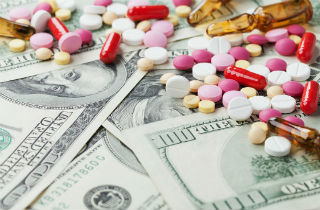How does the illegal drug trade continue to make huge profits?
The simple answer to why the illegal drug trade continues to profit is supply and demand. As long as Americans maintain their insatiable demand for illicit drugs, the drugs dealers will continue to supply and distribute illegal substances for profit.
In fact, according to a study conducted by the ONDCP (Office of National Drug Control Policy), drug users in the United States spent approximately $100 billion annually over the past decade on illicit drugs. The drugs in this study focused on the four most commonly abused illicit drugs which are:
- marijuana
- cocaine (crack)
- heroin
- methamphetamine
Further, SAMHSA (Substance Abuse & Mental Health Services Administration) reports that in 2013, an estimated 24.6 million Americans aged 12 or older, or 9.4 percent of the U.S. population had used an illicit drug in the past month. Although there are casual users of illicit substances, a large portion are addicts who spend hundreds of dollars daily to support their addiction. Their addictions continue to support the illegal drug trade which always profits. And while the recent focus in our country has been on opiates, other drugs like cocaine and methamphetamine are still easily available throughout the country.
Profits come from “cutting” the drugs
By the time illegal drugs are distributed on the street corners of our country, the substances have been “cut” several times with various substances. As a result, the product volume increases and reaches more customers resulting in more profit. What’s added? Substances like:
- sucrose
- lactose
- creatine
- baking soda
- cornstarch
…are often used as “cutting agents” for cocaine and are mixed into the product to increase the quantity for distribution. Various cutting agents are also added to methamphetamine and heroin. Sometimes drugs are cut with dangerous powerful substances like fentanyl or even worse, carfentanil (Elephant tranquilizer) which can cause unintentional overdose.
Profit on the order of many thousands…
How much do drugs cost? The profit potential for illegal drugs is like no other product in existence. For example, a kilogram of pure cocaine can be purchased in a source country like Colombia for as little as $1,500. When the kilogram reaches the U.S., the un-cut retail value increases to as much as $27,000.
However, what was originally a kilogram of cocaine actually becomes a much larger quantity after the additives are mixed in several times during the sale and distribution process.
The drug distributors then begin to “cut” the kilogram multiple times during the distribution phase. A kilogram is 1000 grams and the average street price for a gram of cocaine is $150. So theoretically a kilogram of cocaine should sell for 1000 times (1000 grams) times $150 which is $150,000. This figure may still be low depending on the number of times the distributors “cut” the product.
The profit margin for heroin and methamphetamine is even greater. A kilogram of pure heroin purchased in a source country like Pakistan sells for as little as $2,600 but retails for as much as $130,000 in the United States. Clandestine labs in America and abroad can produce a kilogram of methamphetamine for as little as $300 to $500 but it will retail for as much as $60,000 in the U.S. Drug dealers are profiting so much that they are willing to risk their freedom and lives to earn what they consider easy money.
Are we losing the Drug War?
As a career DEA agent, I have been involved in significant seizures of all types of drugs and thousands of arrests. Although drug dealers are prosecuted and incarcerated, the drug business is only slightly interrupted.
Drug trafficking organizations do their best to avoid arrest, but when a member is arrested, they already have an unlimited number of replacements to take over the distribution business. No matter how many drug dealers are arrested, drug trafficking will continue to operate because it is part of doing business.
Is there a better solution?
The bottom line is all illegal drugs have the potential to make huge profits from the wholesalers to the street level dealers. This will continue in spite of law enforcement seizures and interdiction. As long as there is a demand for illegal drugs, the dealers will continue distributing it with an unlimited supply.
Law enforcement is necessary, but more focus should be on reducing the demand for illegal drugs by increasing education targeting children before they decide to experiment with illegal drugs. There is also a severe lack of available treatment centers for addicts.
——
About the Author: If you would like to learn more illegal drug trends, how to prevent the diversion of pharmaceuticals or receive training from a retired DEA Special Agent Drug Diversion Expert Warren Rivera, please visit www.trainingidea.com or https://www.linkedin.com/in/warren-rivera-aa4a3221
—–









Related Posts